MMA Fighter Jimi Manuwa’s Heavy Hitting Workouts
For this British star, the path to the top of the UFC goes right through some of the most powerful men on earth
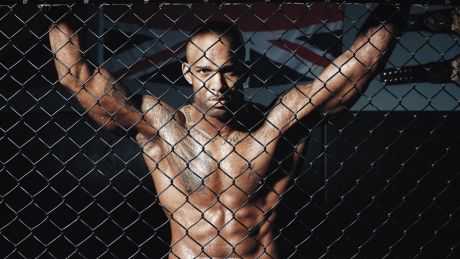
Photography: Glen Burrows
On some level, it’s the same in every sport: to survive at the top, you can’t afford to make mistakes. Tennis players live or die by their unforced error ratios; the best baseball players don’t so much swing for the fences as refuse to strike out.
The difference in the UFC is that even one slip might be enough. Zig when you ought to zag, take a chance in an exchange against the fence or maybe even just blink at the wrong time, and you’re out of title contention for the foreseeable future. This is especially true in the rarified air of the sport’s marquee light heavyweight division, where fighters have the perfect ratio of power, speed and endurance to make almost any shot a knockout. And that’s where Jimi Manuwa makes a living.
“The higher up you get, the more skilled you have to be and the more mistakes you can’t make,” says Manuwa, in between rounds of blasting a heavy bag with his trademark left hook as Men’s Fitness’s photographer tries to catch the perfect shot. “The guys at the top might be born athletes, but they’re also the hardest workers. They don’t mess up.”
Manuwa knows this from experience. But he’s also been on the receiving end of a pair of knockouts himself: one from Alexander Gustafsson, who gave former champion Jon Jones his most competitive ever fight, and one from Anthony “Rumble” Johnson, who throws every shot with terrifying intent. They’re Manuwa’s only career losses – before he came to the UFC, he was undefeated – but he’s sanguine about them.
“I learn from every fight, but especially my losses,” he says. “I’m still getting better every fight. Me and Rumble Johnson are the two hardest hitters in the division, but there’s more to it than that. I’ve learned to be more patient – it’s about having that confidence. I know that I can knock people out – I don’t need to throw everything into every shot, but I don’t waste my shots. I don’t need to throw fours and fives, I can throw one or two and I know I’ll hurt people.”
Power moves
Now Manuwa’s shifted the emphasis of his workouts slightly, to capitalise on his strengths. “With my old coach I was more focused on my cardio and mobility, but that comes with good training,” he explains. “I need to focus more on my power, because that’s the type of fighter I am – an explosive, powerful fighter. It took me a couple of losses and a couple of hard fights to realise that: every fighter’s different.”
Sign up for workout ideas, training advice, reviews of the latest gear and more.
But he’s got no intentions of becoming a grappler or a more timid puncher. “I haven’t changed my style, I’ve tweaked it. I came into the UFC with ten knockouts. I’ve carried that on throughout my career. I’ve always been a knockout artist.”
Does he worry about the variety of fighting styles on display at the sport’s highest echelons? Jones, after all, has been known to throw spinning back elbows and flying knees, while Gustafsson isn’t afraid of the occasional hook kick. “Not so much,” says Manuwa. “As a striker, it doesn’t matter – it’s about those years of training and sparring, of repetition and practice. You can’t just go in and hope for the best. I know how to lure people in. It’s not just hitting the other guy, it’s getting him to do what you want.”
Five by five
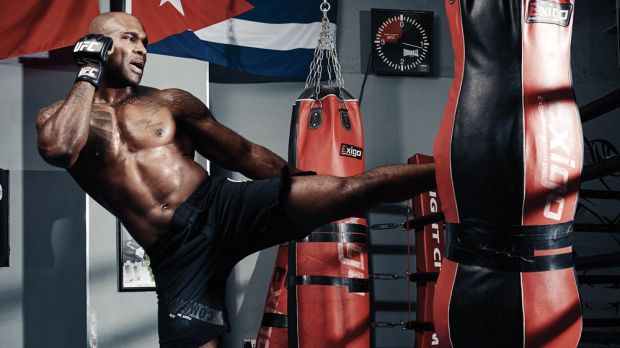
Maybe the biggest shift is just how much tougher fights get as the stakes get higher. Once you’re fighting for the title, or in a card’s main event, fights last for five five-minute rounds instead of three, turning an already-gruelling ordeal into a ferocious test of legs, lungs and heart.
“My coaches have a lot more fun with it,” laughs Manuwa. “They like trying to kill me in training and seeing if I can survive. I hate it, but when it’s done I love it – I know I’m fitter, stronger. I’ll be almost on the floor and they’ll be there going, ‘Are you gonna give up?’ and I’m jumping up going, ‘No! No!’”
Fight camp is a grind: a minimum of two sessions a day, involving everything from sparring (striking starts first thing Monday) to weights to wrestling and Brazilian jiu jitsu. Manuwa takes a slightly different approach to fight camp from most fighters, opting for a three-weeks-on, one-week-off approach that gives his brain and body time to recharge between his hardest sessions. “I’ve got a good family who understand and who support me,” he says. “When it’s not fight time I try to make the most of it. I stay home a lot and enjoy my family, I’ve got young kids. Breaking the camp up just makes it easier to cope.”
It also helps that Manuwa doesn’t subscribe to the boom-and-bust patterns that plague some fighters when it come to fitness: there’s no ballooning up in weight between bouts here. “I still eat healthy pretty much all the time. After the fight I eat the bad stuff, but I almost have to force myself,” says Manuwa. “I might have a few burgers, but I’m still in fight mode – I’m not eating a whole load of junk food. I eat pretty much the same in fight camp as I do in everyday life. A lot of salmon, a lot of chicken, a lot of sweet potato and healthy carbs. I’ve trained myself to enjoy healthy food.” His one weakness? “I don’t cook anything: I don’t even boil eggs. Fortunately, I’ve got a great wife behind me.”
Making waves
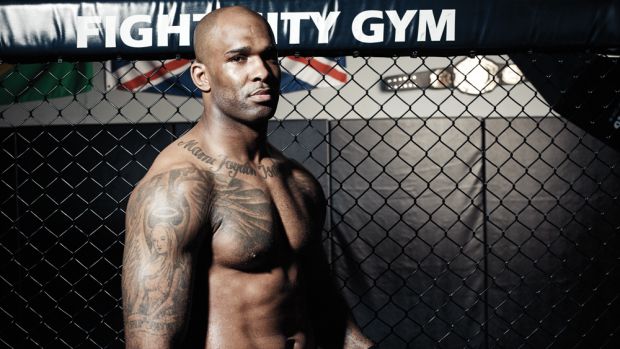
Now, as Manuwa makes his way up the billing, this stuff is more important than ever: training right, eating smart and – especially in the post-Conor McGregor era – being willing to ask for the big fights. Fortunately, for the man nicknamed “Posterboy” this last part is second nature.
When we speak, Manuwa’s 24 hours out from flying to watch champ Daniel Cormier fight Johnson for a second time at UFC 210, and he talks confidently about his future in the division. “I live for this. This is what it’s meant to be like for me, finally getting the recognition that I’ve worked so hard for. I’m going to continue making big waves and doing big things. I’m bigger, stronger faster, I’ve got better cardio than I ever have. There’s a lot more good stuff to come.”
Two days later, he’s ringside as Cormier – despite suffering a broken nose in the first round – chokes Rumble into submission in the second. Then there’s a surprise: Johnson, after his second loss to the champ, announces that he’s done with fighting and heading elsewhere. That’s Manuwa’s shot at avenging his biggest loss gone – but he’s already on his feet, looking at the champion.
“Sit down, young man,” grins Cormier, who only has eyes for former champ Jones, set to return from suspension to what’s sure to be a box-office busting title match. Manuwa just smiles back. In this game, at this level, it’s all about making fewer mistakes than the other guy. And underestimating Manuwa might be the biggest mistake any rival could make.
Watch Jimi Manuwa in action at UFC 214: Cormier vs Jones 2 live on BT Sport on Saturday 29th July
Jimi Manuwa’s Punching Tips
Whether you’re doing HIIT or stepping into the ring, throwing harder punches is about technique and efficiency. Manuwa’s here to give you your shots
Jab
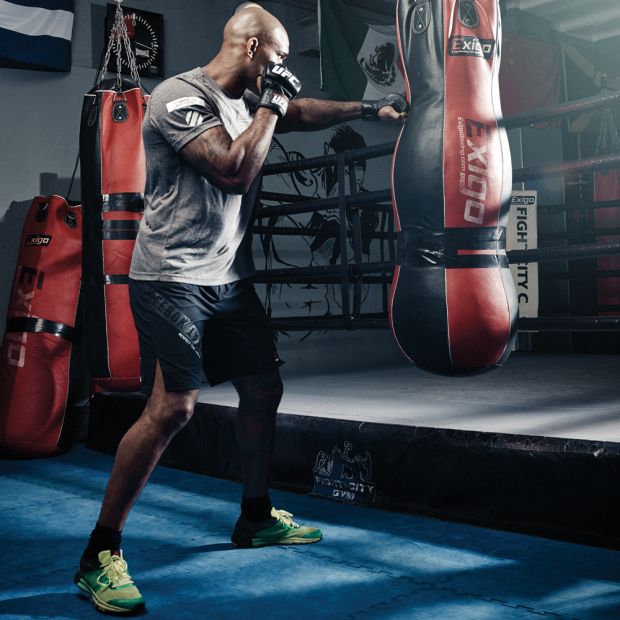
The most basic punch in boxing, and Manuwa uses it to manoeuvre opponents into positions that allow him to hit them harder. Stand slightly side-on, step forward with your left foot as you throw, and twist your hips slightly as you throw it to head height. And for now, keep your hands up between punches. “Are you protecting yourself while you throw it?” asks Manuwa. “You don’t always have to have your hands up, you can be unorthodox, but learning when that works takes experience.”
Cross
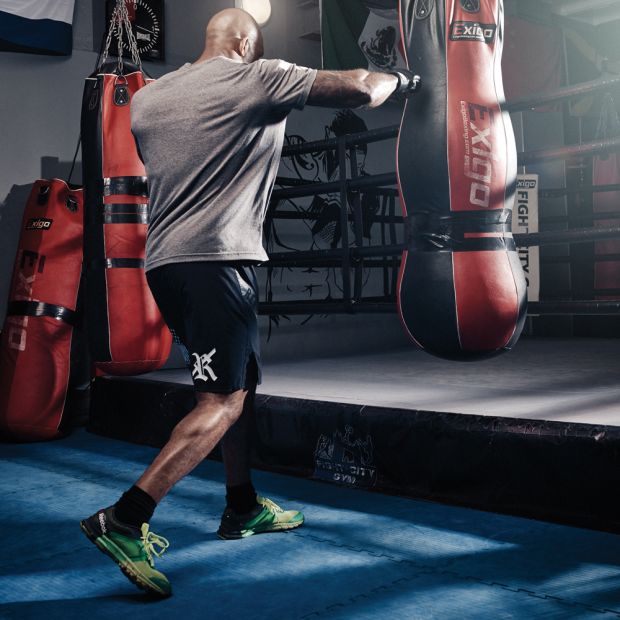
The power punch: slower to land than the jab, but harder with it – Manuwa used his to hurt top contender Ovince Saint Preux at UFC 204 before putting him away with his trademark left. To throw it, twist on the ball of your back foot (your right for an orthodox fighter) like you’re crushing a cigarette, twisting your hips into the punch. “Once you’ve got the hang of it, try to watch yourself doing it,” says Manuwa. “Where are you starting and finishing? How does it feel? Tweak it to fit you.”
Left Hook

Manuwa’s knockout punch: he used it to put away The Ultimate Fighter winner Corey Anderson in the first round of their Fight Night bout in March. Keeping your lead elbow at a slight angle, twist your body and throw this one thumb-up for power, or palm-down for range. “Work on throwing it as a body shot,” says Manuwa. “When you’re shadowboxing, try slipping an imaginary punch and throwing it to the ribs.”
RECOMMENDED: Punching-Bag Workouts
Build Combat Conditioning
Forget roadwork: when he’s in training camp, Manuwa does five-minute rounds of this circuit, aiming to get as many reps as possible before the bell. To prepare for UFC main events, he does five rounds a workout, but you should start with three
Pull-up

Reps 8
Arms straight at the bottom, chest over the bar at the top. Using a bit of knee drive to squeak out some extra reps is OK as you get towards the end of the round. Do eight reps – or about half as many as you can do in one go.
Lateral Slam

Reps 8
Pick up a medicine ball, bring it overhead and slam it to the ground – if you just drop it, you’re only cheating yourself. If you’ve got two balls, set them up 10m apart and shuffle laterally from one to the other between reps (if you’ve only got one, go out and back).
Inverted Row
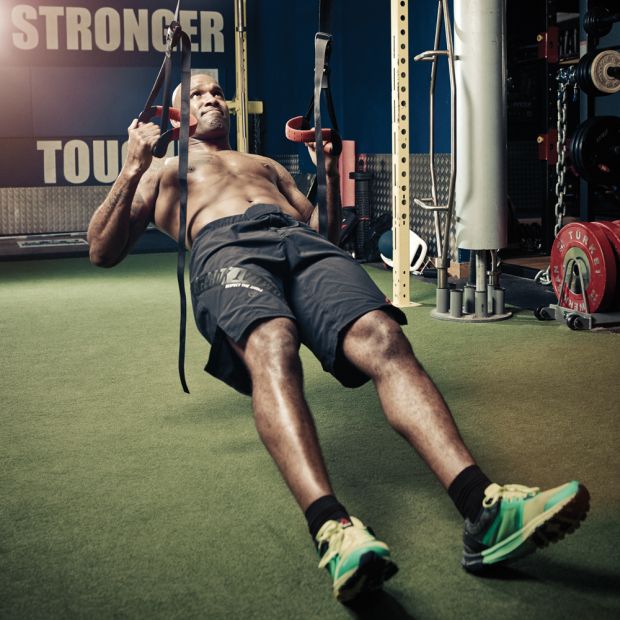
Reps 8
Set up a suspension trainer or pair of gymnastic rings at chest height, then hold them and lean back with straight legs. Pull your elbows behind you, keeping them tight to your body. As the reps get tougher, it’s OK to stand up straighter – conditioning is key.
Battle Rope Slam
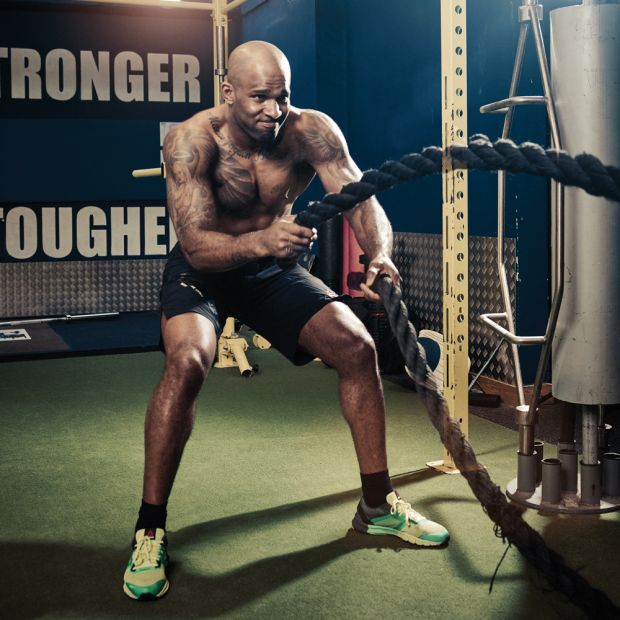
Time 10sec
Finish your circuit with an all-out burst on a set of battle ropes. Make waves as fast as possible, then go straight into your next set of pull-ups. Aim to do as many circuits as possible (at least three) while keeping the intensity high.
RECOMMENDED: Battle Ropes Workouts
Power Routine
Manuwa uses full-body movements to build all-round power for the Octagon. Get stronger with this classic double whammy
Back squat
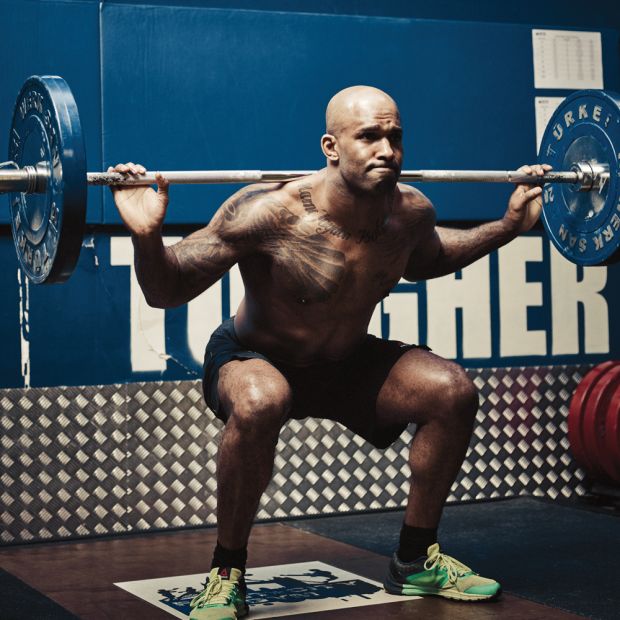
Reps 6 Sets 4
Rest the bar against the back of your shoulders – not on your neck – and hold it using an overhand grip, hands slightly wider than shoulder-width apart. Keep your elbows pointing down. Your feet should be a little more than shoulder-width apart, with your toes pointing outwards slightly. Squat until your thighs are at least parallel to the floor. The deeper you can squat, the better. Drive back up through your heels to return to the start position.
Power clean
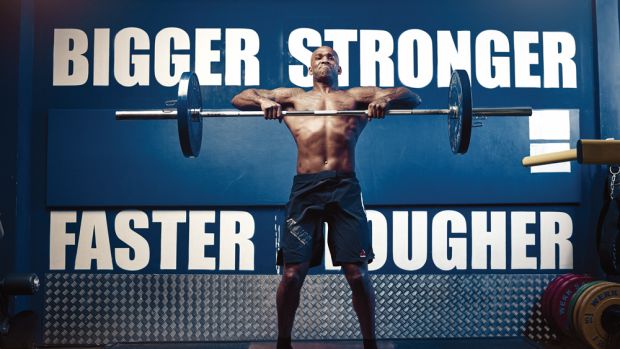
Reps 6 Sets 5
Grip a bar with your hands roughly shoulder-width apart. Drive through your heels to lift it off the floor, then, as it passes your knees, use your hips to drive up and lift the bar explosively. Catch it at your chest. When all your reps are done, either put the bar in the rack to get ready for your squats, or push press it overhead and lower it.
From 2008 to 2018, Joel worked for Men's Fitness, which predated, and then shared a website with, Coach. Though he spent years running the hills of Bath, he’s since ditched his trainers for a succession of Converse high-tops, since they’re better suited to his love of pulling vans, lifting cars, and hefting logs in a succession of strongman competitions.

